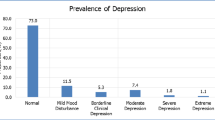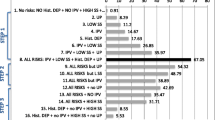Abstract
Background
The aim of the study was to identify risk factors for depression and to estimate its prevalence in postnatal mothers.
Methods
This cross-sectional and multi-centre study was carried out on 1,350 Turkish women in their first postnatal year. Measures included a structured questionnaire and the Turkish version of the Edinburgh Postnatal Depression Scale (EPDS).
Results
Of the women, 31.1% had a score of 13 or higher on the EPDS. The mean score and standard deviation was 9.8±5.7. In the multivariate analysis, EPDS scores were significantly associated with economic status, access to support from family members and close friends, emotional distress at the pregnancy, whether the pregnancy was planned, health problems during pregnancy, the perceived standard of baby care after delivery, and mental disorder before and during pregnancy.
Conclusion
The prevalence of EPDS-based depression among Turkish women in postnatal the period was high, and was associated with several social, economic and demographical factors.
Similar content being viewed by others
References
Baker D, North K (1999) Does employment improve the health of lone mothers? The ALSPAC Study Team. Avon Longitudinal Study of Pregnancy and Childhood. Soc Sci Med 49(1):121–131
Ballard CG, Davis R, Cullen PC, Mohan RN, Dean C (1994) Prevalence of postnatal psychiatric morbidity in mothers and fathers. Br J Psychiatry 164:782–788
Barnett B, Matthey S, Gyaneshwar R (1999) Screening for postnatal depression in women of non-English speaking background. Arch Women Ment Health 2:67–74
Bergant AM, Heim K, Ulmer H, Illmensee K (1999) Early postnatal depressive mood: associations with obstetric and psychosocial factors. J Psychosom Res 46(4):391–394
Bernazzani O, Bifulco A (2003) Motherhood as a vulnerability factor in major depression: the role of negative pregnancy experiences. Soc Sci Med 56(6):1249–1260
Bernazzani O, Saucier JF, David H, Borgeat F (1997) Psychosocial predictors of depressive symptomatology level in postpartum women. J Affect Disord 46:39–49
Boat EH, Pryce AJ, Cox JL (1998) Postnatal depression: the impact on the family. J Reprod Infant Psychol 16:199–203
Bridge LR, Little BC, Hayworth J, Dewhurst J, Priest RG (1985) Psychometric antenatal predictor of post-natal depressed mood. J Psychosom Res 29:325–331
Bryan TL, Georgiopoulos AM, Harms RW, Huxsahl JE, Larson DR, Yawn BP (1999) Incidence of postpartum depression in Olmsted County, Minnesota. A population-based, retrospective study. J Reprod Med 44(4):351–358
Carter J (1992) Ed. Postnatal depression: towards a research agenda for human services and health. Commonwealth Department of Human Services and Health, Canberra
Chaaya M, Campbell OM, El Kak F, Shaar D, Harb H, Kaddour A (2002) Postpartum depression: prevalence and determinants in Lebanon. Arch Women Ment Health 5(2):65–72
Cooper PJ, Tomlinson M, Swartz L, Woolgar M, Murray L, Molteno C (1999) Post-partum depression and the mother–infant relationship in a South African peri-urban settlement. Br J Psychiatry 175:554–558
Cox JL (1988) Childbirth as a life event: socio-cultural aspects of postnatal depression. Acta Psychiatr Scand 344:75–82
D'Alfonso A, Iovenitti P, Casacchia M, Carta G (2002) Disturbances of humour in postpartum: our experience. Clin Exp Obstet Gynecol 29(3):207–211
Danaci AE, Dinc G, Deveci A, Sen FS, Icelli I (2002) Postnatal depression in turkey: epidemiological and cultural aspects. Soc Psychiatry Psychiatr Epidemiol 37(3):125–129
Danker R, Goldberg RP, Fisch RZ, Crum RM (2000a) Cultural elements of postpartum depression. J Reprod Med 45:97–104
Danker R, Goldberg RP, Fisch RZ, Crum RM (2000b) Cultural elements of postpartum depression. A study of 327 Jewish Jerusalem women. J Reprod Med 45:97–104
Eberhard-Gran M, Eskild A, Tambs K, Samuelsen SO, Opjordsmoen S (2002) Depression in postpartum and non-postpartum women: prevalence and risk factors. Acta Psychiatr Scand 106(6):426–433
Engindeniz AN, Kuey L, Kultur S (2000) The Turkish version of Edinburgh Postnatal Depression Scale; a study of validity and reliability. Spring Symposium First Book. Psychiatry Association Press, Ankara
Georgiopoulos AM, Bryan TL, Yawn BP, Houston MS, Rummans TA, Therneau TM (1999) Population-based screening for postpartum depression. Obstet Gynecol 93:653–657
Georgiopoulos AM, Bryan TL, Wollan P, Yawn BP (2001) Routine screening for postpartum depression. J Fam Pract 50(2):117–122
Ghubash R, Abou-Saleh MT (1997) Postpartum psychiatric illness in Arab culture: prevalence and psychosocial correlates. Br J Psychiatry 171:65–68
Glasser S, Barell V, Boyko V, Ziv A, Shoham A, Hart S (2000) Postpartum depression in Israeli cohort: demographic, psychosocial and medical risk factors. J Psychosom Obstet Gynaecol 21:99–108
Gray AM (2002–2003) Screening in Scotland. NCS Programmes Director's Report, Summer
Hughes PM, Turton P, Evans CD (1999) Stillbirth as risk factor for depression and anxiety in the subsequent pregnancy: cohort study. BMJ 318(7200):1721–1724
Inandi T, Elci OC, Ozturk A, Egri M, Polat A, Sahin TK (2002) Risk factors for depression in postnatal first year, in eastern Turkey. Int J Epidemiol 31(6):1201–1207
Johnstone SJ, Boyce PM, Hickey AR, Morris-Yatees AD, Harris MG (2001) Obstetric risk factors for postnatal depression in urban and rural community samples. Aust N Z J Psychiatry 35(1):69–74
Josefsson A, Angelsioo L, Berg G, Ekstrom CM, Gunnervik C, Nordin C, Sydsjo G (2002) Obstetric, somatic, and demographic risk factors for postpartum depressive symptoms. Obstet Gynecol 99(2):223–228
Kumar R (1994) Postnatal mental illness: a trans-cultural perspective. Soc Psychiatry Psychiatr Epidemiol 29:250–264
Lane A, Keville R, Morris M, Kinsella A, Turner M, Barry S (1997) Postnatal depression and elation among mothers and their partners: prevalence and predictors. Br J Psychiatry 171:550–555
Lee DTS, Yip SK, Chiu HFK et al (1998) Detecting postnatal depression in Chinese women. Validation of the Chinese version of the Edinburgh Postnatal Depression Scale. Br J Psychiatry 172:433–437
Misri S, Kostaras X, Fox D, Kostaras D (2000) The impact of partner support in the treatment of postpartum depression. Can J Psychiatry 45(6):554–558
Nielsen Forman D, Videbech P, Hedegaard M, Dalby Salvig J, Secher NJ (2000) Postpartum depression: identification of women at risk. BJOG 107(10):1210–1217
Patel V, DeSouza N, Rodrigues M (2003) Postnatal depression and infant growth and development in low income countries: a cohort study from Goa, India. Arch Dis Child 88(1):34–37
Republic of Turkey, Prime Ministry (2000) State planning organization. The project of East Anatolia, Ankara
Republic of Turkey, Prime Ministry (2002) State institute of statistics. Population census, Ankara
Romito P, Saurel-Cubizolles MJ, Lelong N (1999) What makes new mothers unhappy: psychological distress one year after birth in Italy and France? Soc Sci Med 49(12):1651–1661
Seguin L, Potvin L, St-Denis M, Loiselle J (1999) Depressive symptoms in the late postpartum among low socioeconomic status women. Birth 26(3):157–163
Sugawara M, Toda MA, Shima S, Mukai T, Sakakura K, Kitamura T (1997) Premenstrual mood changes and maternal mental health in pregnancy and the postpartum period. J Clin Psychol 53(3):225–232
Tammentie T, Tarkka MT, Astedt-Kurki P, Paavilainen E (2002) Sociodemographic factors of families related to postnatal depressive symptoms of mothers. Int J Nurs Pract 8(5):240–246
Thome M (2000) Predictors of postpartum depressive symptoms in Icelandic women. Arch Women Ment Health 3:7–14
Warner R, Appleby L, Whitton A, Faragher B (1996) Demographic and obstetric risk factors for postnatal psychiatric morbidity. Br J Psychiatry 168(5):607–611
Webster ML, Thompson JM, Mitchell EA, Werry JS (1994) Postnatal depression in a community cohort. Aust N Z J Psychiatry 28(1):42–49
World Health Organization (1997) Nations for mental health—a focus on women. WHO, Geneva 1–5
World Health Organization (2000) Women's mental health: an evidence based review. WHO, Geneva, 31–44
Acknowledgements
We would like to thank the mothers who participated in this study.
Author information
Authors and Affiliations
Corresponding author
Rights and permissions
About this article
Cite this article
Inandi, T., Bugdayci, R., Dundar, P. et al. Risk factors for depression in the first postnatal year. Soc Psychiat Epidemiol 40, 725–730 (2005). https://doi.org/10.1007/s00127-005-0949-3
Accepted:
Published:
Issue Date:
DOI: https://doi.org/10.1007/s00127-005-0949-3




